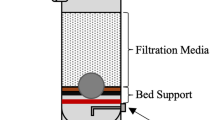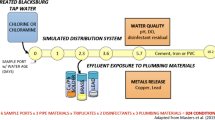Abstract
The Hanford site is located in southeastern Washington State and stores more than 200,000 m3 (55 million gallons) of high-level radioactive waste resulting from the production and processing of plutonium. The waste is stored in large carbon steel tanks that were constructed between 1943 and 1986. The leak and structurally integrity of the more recently constructed double-shell tanks must be maintained until the waste can be removed from the tanks and encapsulated in glass logs for final disposal in a repository. There are a number of corrosion-related threats to the waste tanks, including stress–corrosion cracking, pitting corrosion, and corrosion at the liquid–air interface and in the vapor space. This article summarizes the corrosion management program at Hanford to mitigate these threats.







Similar content being viewed by others
References
R.W. Harvey, Management of Radioactive Wastes Stored in Underground Tanks at Hanford, ARH-R-43, Rev. 2, OSTI ID: 4358331 (Richland, WA: Atlantic Richfield Hanford, Co., April 1970), www.osti.gov/bridge.
K.D. Boomer, Single Shell Tank History, WRPS-40224-VA (Richland, WA: Washington River Protection Solutions, 2009).
P.J. Certa, P.A. Empey, and M.N. Wells, River Protection Project System Plan, ORP-11242, Rev. 6 (Washington, DC: U.S. Department of Energy, 2011).
G.L. Edgemon. V.S. Anda, H.S. Berman, M.E. Johnson, and K.D Boomer, CORROSION/08 (Houston, TX: NACE International, 2008), Paper No. 08RTS-01.
S.H. Rifaey, Single Shell Tank Integrity Assessment Report, RPP-10435, Rev. 0 (Richland, WA: CH2 M Hill Hanford Group, 2002).
R.P. Anantatmula, E.B. Schwenk, and M.J. Danielson, Characterization of the Corrosion Behavior of the Carbon Steel Liner in Hanford Site Single-Shell Tanks, WHC-EP-0772, Rev. 0 (Richland, WA: Westinghouse Hanford Company, 1994).
D.C. Bryson, D.J. Washenfelder, and K.D. Boomer, Progress in Hanford’s Double-Shell Tank Integrity Project, CH2 M-36343-FP (Richland, WA: CH2 M Hill, 2008).
F.C. Han, Structural Integrity and Potential Failure Modes of the Hanford High-Level Waste Tanks, WHC-SD-TWR-RPT-002 (Richland, WA: Westinghouse Hanford Company, 1996).
S.J. Harrington and T.L. Sams, Discovery of the First Leaking Double Shell Tank? Hanford Tank 241-AY-102-14222, WRPS-55823-FP-Rev. 0 (Richland, WA: Washington River Protection Solutions, 2013).
J.K. Engeman, C.L. Girardot, D.G. Harlow, and C.L. Rosenkrance, Tank 241-AY-102 Leak Assessment Report, RPP-ASMT-53793 (Richland, WA: Washington River Protection Solutions, 2013).
R.N. Parkins and R. Usher, Proceedings First International Congress on Metallic Corrosion (London, U.K.: Butterworths, 1962), pp. 296–302.
L.M. Stock, J.R. Follett, and E.C. Shallman, Specifications for the Minimization of the Stress Corrosion Cracking Threat in Double Shell Tank Wastes, RPP-RPT-47337, Rev. 0 (Richland, WA: Washington River Protection Solutions, 2011).
G.L. Edgemon, G. Bell, D. Wilson, and S.J. Pawel, CORROSION/96 (Houston, TX: NACE International, 1996), Paper No. 96094.
H. Cong, F. Gui, C.S. Brossia, J.A. Beavers, G.S. Frankel, G.L. Edgemon, K. Boomer, and B. Wiersma, CORROSION/11 (Houston, TX: NACE International, 2011), Paper No. 11212.
R.B. Hammer, Unclassified Operating Specifications for the 241-AN, AP, AW, AY, AZ, & SY Tank Farms, Rev/Mod H-21, OSD-T-151-00007 (Richland, WA: Washington River Protection Solutions, LLC, 1998).
R.S. Rast, Operating Specifications for the Double-Shell Storage Tanks, Rev. 6, OSD-T-151-00007 (Richland, WA: Washington River Protection Solutions, LLC, 2010).
L.A. Fort, D.A. Reynolds, K.G. Carothers, M.A. Knight, and M.J. Klem, Technical Basis for Chemistry Control Program, RPP-7795 (Richland, WA: CH2 M Hill Hanford Group Inc., 2001).
E.N. Hoffman, P.E. Zapp, B.J. Wiersma, and K.H. Subramanian, CORROSION/09 (Houston, TX: NACE International, 2009), Paper No. 09432.
R.T. Pabalan, V. Jain, R.F. Vance, S. Loannidis, D.A. Pickett, C.S. Brazel, J.T. Persyn, E.J. Taylor, and M.E. Inman, Hanford Tank Waste Remediation System Pretreatment Chemistry and Technology, NUREG/CR-6714 (Washington, DC: U.S. Nuclear Regulatory Commission, 2001).
M. Terry, J. Beavers, C. Czajkowski, G. Frankel, B. Gordon, L. Stock, B. Wiersma, and P. Zapp, Expert Panel Workshop for Hanford Site Double-Shell Tank Waste Chemistry Optimization, RPP-RPT-22126, Rev. 0 (Richland, WA: CH2 M Hill, 2004).
C.S. Brossia, C.S. Scott, J.A. Beavers, G.L. Edgemon, H. Berman, G.S. Frankel, and K. Boomer, CORROSION/08 (Houston, TX: NACE International, 2008), Paper No. 08599.
C.S Brossia, Hanford Tanks AY-102 and AP101: Effect of Chemistry and Other Variable on Corrosion and Stress Corrosion Cracking, RPPT-33284, Rev. 1 (Richland, WA: CH2 M Hill Hanford Group Inc., 2008).
C.S. Brossia, Hanford Tank AY-101: Effect of Chemistry and Other Variable on Corrosion and Stress Corrosion Cracking, RPP-RPT-35923, Rev. 0 (Richland, WA: CH2 MHill Hanford Group Inc., 2008).
F. Gui, C.S. Brossia, and C. Scott, Final Report: Effect of Chemistry and Other Variables on Corrosion and Stress Corrosion Cracking of Hanford Tanks, Company Report, RPP-RPT-42703, Rev. A (Richland, WA: Washington River Protection Solutions, LLC, 2009).
C.S. Scott, F. Gui, C.S. Brossia, J.A. Beavers, G.L. Edgemon, K.D. Boomer, G.S. Frankel, B.J. Wiersma, and L. Stock, CORROSION/09 (Houston, TX: NACE International, 2009), Paper No. 09434.
J.A. Beavers, C.S. Brossia, F. Gui, C. Scott, H. Cong, N. Sridhar, B.J. Wiersma, G.S. Frankel, and K. Boomer, CORROSION/2014 (Houston, TX: NACE International, 2014), Paper C2014-3754.
ASTM G129-00, Standard Practice for Slow Strain Rate Testing to Evaluate the Susceptibility of Metallic Materials to Environmentally Assisted Cracking (West Conshohocken: ASTM International, 2006).
ASTM G61-86, Standard Test Method for Conducting Cyclic Potentiodynamic Polarization Measurements for Localized Corrosion Susceptibility of Iron-, Nickel-, or Cobalt-Based Alloys (Conshohocken: American Society for Testing and Materials, 2009).
V.S. Anda, G.L. Edgemon, A.R. Hagensen, M.M. Dahl, K.G. Carothers and K.D. Boomer, CORROSION/10 (Houston, TX: NACE International, 2010), Paper No. 10243.
F. Gui, C.S. Brossia, J.A. Beavers, G.S. Frankel G.L. Edgemon, H. Berman, and L. Stock, CORROSION/2008 (Houston, TX: NACE International, 2008), Paper 08589.
F. Gui, C. Scott, and S. Brossia, Hanford Tanks AP105, SY103 and AW105: Effect of Chemistry and other Variables on Corrosion and Stress Corrosion Cracking, RPP-RPT-35923, Rev. 0, U.S. Department of Energy Contract DE-AC27-99RL14047 (Richland, WA: CH2 M Hill Hanford Group Inc., 2008).
F. Gui, C. Scott, S. Brossia, and H. Cong, Investigation of Liquid Air Interface Corrosion, Inhibitor Performance and Critical Cracking Potential in Hanford Tank Waste Simulants, RPP-RPT-42704, Rev. A, U.S. Department of Energy Contract DE-AC27-99RL14047 (Richland, WA: Washington River Protection Solutions Inc., 2009).
F. Gui, H. Cong, C.S. Brossia, J.A. Beavers, G.S. Frankel, G.L. Edgemon, K. Boomer, and B. Wiersma, CORROSION/2010 (Houston, TX: NACE International, 2010), Paper 10247.
H. Cong, C.S. Brossia, J.A. Beavers, G.S. Frankel, B. Wiersma, K. Boomer, G.L. Edgemon, and L. Stock, CORROSION/12 (Houston, TX: NACE International, 2012), Paper No. C2012-0001562.
M. Terry, J. Beavers, G. Frankel, J. Huckaby, L. Stock, K. Subramanian, and B. Wiersma, Expert Panel Workshop on Double-Shell Tank Vapor Space Corrosion Testing, RPP-RPT-31129, Rev. 0 (Richland, WA: CH2M Hill, 2006).
K.H. Subramanian, B.J. Wiersma, and P.E. Zapp, CORROSION/09 (Houston, TX: NACE International, 2009), Paper No. 09436.
R.P. Anantatmula, M.J. Danielson, and D.B. Mackey, Vapor Phase Pitting Results of ASTM A516 and A537 Carbon Steels Over Three Different Aqueous Solutions After One Month and Three Month Exposures, WHC-SD-WM-PRS-016, Rev. 0, Appendix 2 (Richland, WA: Westinghouse Hanford Company, 1996).
A.R. Felmy, O. Qafoku, B. Arey, and K.D. Boomer, Chemical Species in the Vapor Phase of Hanford Double-Shell Tanks: Potential Impacts on Waste Tank Corrosion, PNNL-19767, Contract DE-AC05-76RL01830 (Richland, WA: Pacific Northwest National Laboratory, 2010).
E.N. Hoffman, Testing Vapor Space and Liquid-Air Interface Corrosion in Simulated Environments of Hanford Double-Shelled Tanks, SRNL-STI-2011-00494, DOE Contract Number DE-AC09-08SR22470 (Aiken, SC: Savannah River National Laboratory, 2011).
Acknowledgements
The authors acknowledge the efforts of several people, whose results are referenced in this report: C.S. Brossia, F. Gui, H. Cong, K. Sherer, J. Gerst, S. Finneran, and C. Scott. The guidance of the following EPOC members to these investigations is acknowledged, D. Camaioni, G. Frankel, R. Jones, L. Stock, M. Terry, and B. Wiersma.
Author information
Authors and Affiliations
Corresponding author
Rights and permissions
About this article
Cite this article
Beavers, J.A., Sridhar, N. & Boomer, K.D. Corrosion Management of the Hanford High-Level Nuclear Waste Tanks. JOM 66, 491–502 (2014). https://doi.org/10.1007/s11837-014-0877-3
Received:
Accepted:
Published:
Issue Date:
DOI: https://doi.org/10.1007/s11837-014-0877-3




